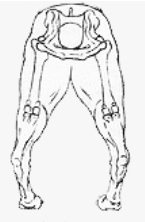
In people, feet that point inwards are regarded as being “pigeon-toed,” but in canines, when a dog’s hocks turn outward, they cause feet to toe in, and then the dog is referred to as being “barrel hocked,” “spread hocked,” or “open hocked.”
Sometimes it happens when there’s more muscle mass on the outside of the rear legs than the inside, and sometimes the bones that form the rear quarters are too short, the angles too obtuse. It’s the opposite of cow hocks, but both affect stability in a dog’s rear end. If you notice this on your dog, it means that you continue to love your dog, but you should be aware of the physical activities you’re asking of your dog. Agility courses, a lot of jumping and landing, perhaps getting on and off the bed without a ramp – these are things you may want to reconsider or rectify. Because your dog loves you, he’ll gamely do what you ask of him, but it’s probably not in his best interest for the long run when it comes to being pain free in his joints.
We’ve had this image for ages and never did know where it came from, but we’ll happily credit it if you can provide us more information.

Is it possible for a dog, in this case my golden retriever to have this issue in only one leg? He stands with his right rear foot internally rotated while the other foot is facing forward. He does not exhibit any pain and the vets dont seem to have a clue.
We’re not experts either, Joseph, but it would seem plausible that the issue can manifest in one foot. How old is he and how long has he exhibited this?
I have a Yorkie mix whose front legs turn inwards, one leg almost 90 degrees. What causes that? He is 13 years old and also appears to be barrel hocked. I presume it is all genetics.
At thirteen years of age, Ron, it could be anything, and you don’t mention if he’s been this way since a pup. We’re not medical experts and if causes him distress, of course you’d want him seen by a vet. In the end, however, you could be right about his genetics.
His condition was not noticeable as a pup but insidiously became worse over the years. He is seen by a vet every year and her solution centers around pain relief/management (Galiprant/Metacam). We minimize his jumping and long walks are out of the question. Thanks.